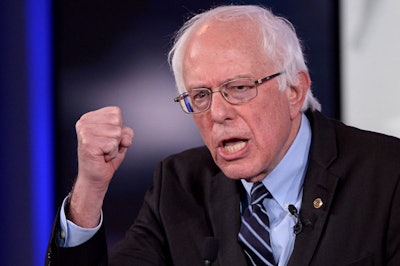 Bernie Sanders
Bernie SandersWASHINGTON — If the nation’s high school students had their way — including those who plan to vote this November — Sen. Bernie Sanders, D-Vt., would be the nation’s next president, a new survey released Thursday shows.
Specifically, among first-time voters in November, Sanders would garner 35 percent of the vote, followed by billionaire businessman Donald Trump (R), who would get 19 percent, then former U.S. Secretary of State Hillary Clinton (D) and Sen. Ted Cruz, R-Texas, who would get 12 and 8 percent, respectively.
The survey — conducted by My College Options, a college-planning organization, and the Hispanic Heritage Foundation — shows that the election would take a very different course than the one it has taken based on the preferences of older voters, for whom Trump and Clinton are the favored White House contenders.
Facilitators of the survey — now in its third iteration after being used in the 2008 and 2012 elections — believe it offers profound insights into the thinking of America’s youngest voters.
“I look at this survey as providing us all with important guidance on how to better understand and serve our youth,” said Jose Antonio Tijerino, president and CEO of the Hispanic Heritage Foundation, a Fairfax, Va.-based organization that works to prepare young Latinos for positions of leadership.
The survey found great divergence among students from different racial and ethnic backgrounds when it came to ranking the nation’s most important issues.
While all students agreed that the economy and education are the two most important issues, different groups had different views on which issue came next.
For instance, 30 percent of Black students thought racism and race relations was the most important issue, making it the third most important issue within their group. However, among White students, gun rights was the third most important issue, and only 10 percent felt race and racism was the most important issue.
Gun rights also was the third most important issue among American Indian students.
For Hispanic students, immigration was the third top issue, and for Asian and Middle Eastern students, the third most important issue was health care.
Sanders was the most popular candidate among all racial and ethnic groups, but the least popular among White students, who were nearly evenly split between Trump at 26 percent, and Sanders at 27 percent.
If anything, the survey — which is live and interactive and allows users to filter the results by state and racial and ethnic groups — show that students from diverse backgrounds live in very different political realities and maintain vastly different sets of priorities and interests.
Sharp divides also separate students by race and ethnicity along lines of political party affiliation. For instance, 63 and 60 percent of African-Americans and Latinos were more likely to identify as Democrat, whereas 52 percent of Whites were likely to identify as Republican.
The survey also found variation by race and ethnicity on the question of whether the country is headed in the right direction and approval for the performance of President Barack Obama.
For instance, among Black students, 41 percent do not believe the country is headed in a positive direction, but 74 percent approve of the job of President Obama.
Among White students, however, 55 percent do not believe the country is headed in a positive direction, and 42 percent disapprove of the job of President Obama.
Among Hispanics, 43 percent do not believe the country is going in a positive direction and 59 percent approve of the job of President Obama.
Of course, based on how students ranked the most important issues, deeper issues lie underneath the reasons why different groups feel Obama is doing a good job or not and whether the country is headed in a positive direction or not.
The study sample represents nearly 1,100 high schools and more than 103,000 students. The survey will be repeated again this fall closer to the 2016 presidential election, organizers say.
Some observers suggest the current survey results show that, if Sanders — the favorite candidate of the high schoolers — is no longer in the race and Clinton wins the Democratic nomination, Clinton will have to do some significant adjusting to engage students who currently back Sanders.
Jamaal Abdul-Alim can be reached at [email protected] or follow him on Twitter @dcwriter360.



















